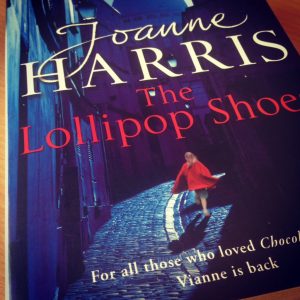Some books call to you from a shelf; that silent yet persuasive voice that gets inside your head and tells you that you want, nay, need, to read them. Right now.
 This happens to me quite often – as a compulsive book-buyer, this voice doesn’t need to shout any more, it just nudges me in the right direction and knows that I’ll comply, rolling its eyes (mixed metaphor, but you know what I mean) at the inevitability of it all – but not quite so compulsively as with Joanne Harris’ The Lollipop Shoes. I’m late to the Joanne Harris party; the book came out in 2007, and follows Chocolat, written in 2001 (which I hadn’t read either), so I have some catching up to do. The siren-call of The Lollipop Shoes isn’t hard to fathom – a heady blend of the front cover’s design, the heft of the book in the hand, the feel of the pages – and I succumbed instantly.
This happens to me quite often – as a compulsive book-buyer, this voice doesn’t need to shout any more, it just nudges me in the right direction and knows that I’ll comply, rolling its eyes (mixed metaphor, but you know what I mean) at the inevitability of it all – but not quite so compulsively as with Joanne Harris’ The Lollipop Shoes. I’m late to the Joanne Harris party; the book came out in 2007, and follows Chocolat, written in 2001 (which I hadn’t read either), so I have some catching up to do. The siren-call of The Lollipop Shoes isn’t hard to fathom – a heady blend of the front cover’s design, the heft of the book in the hand, the feel of the pages – and I succumbed instantly.
What beguiled me about the book from fairly early on was the rise and fall of the rhythm of the prose, the cadences, the dance between duple and triple metre – as a musician, it’s hard not to notice this aspect of any sound that reaches the ear – but this was the first time it had been so striking. It wasn’t just telling a story; the words were more akin to a kind of invocation, entirely appropriate for a story concerning the power of spells, of magic.
‘Death grins out from the woodcut design; jealous, joyless, hollow-eyed, hungry – Death the insatiable; Death the implacable; Death the debt we owe to the gods.’
It’s not just the sound of the words operating here – assonance, alliteration – it’s the way they are struck, too; the triplet-metre feel that moves to a duple-metre feel at the same time as the alliterative passage ‘jealous, joyless.’ The metric change imparts, quite deliberately, a more leaden tread to the manner in which the passages steps, in contrast to the 6/8 metre that surrounds it.
‘So many lives just there for the taking; there for the tasting, for someone like me.’
Again, it’s that mixture of sound and rhythm, the subtle shift from ‘taking’ to ‘tasting’ and the rhythm of the sentence that has me hearing it sung in haunting tones by someone like folk-singer, Mary Hampton. Whole passages seem to pass by in a stately dance; it’s impossible not to be hypnotised. Joanne’s prose does this a lot – in fact, it was difficult to read the whole of chapter Four without hearing the prose’s inner music and rhythm pulling the ear.
And that, perhaps, is what the book is all about; not just telling the reader about the power of magic, but actually working its own enchantment, too. With this novel, it’s not only about where the story takes you – it’s about the how, the way in which it does so, too. The excitement about contemporary music is very similar; not just ending up in a new landscape, but being taken there in an unexpected fashion, with new encounters along the way. Joanne’s book has this same appeal; sometimes dancing with the Puckish feel of a Tippett string quartet, elsewhen stepping with the poise of a stately gavotte.
Its bewitchment was such that I went out in a daze and binge-bought five more, helpless in the grip of a need to read further. I can never enter a bookshop without weeping in sheer frustration ‘But there’s so much to READ!’ No matter how much I read, more books are coming out all the time, and I’ll never be able to keep up. But that’s part of the attraction, the unattainable goal that you know you can never reach but one towards which you’re always being driven. My daughter needs a book for a Year 8 project this term: needless to say, I pressed this into her hand crying ‘This one! THIS ONE! You’ll love it; there’s love, magic, chocolate, and an inner music…’ I hope she does.
I’m late to the Joanne Harris party, it’s true; but I’m excited to be here…
